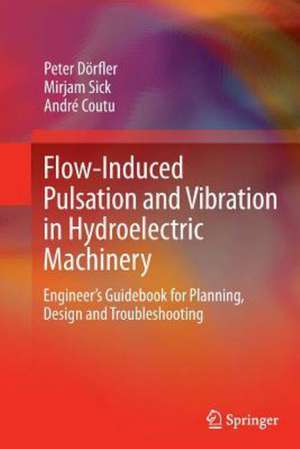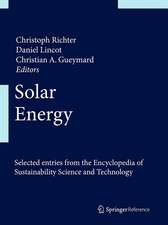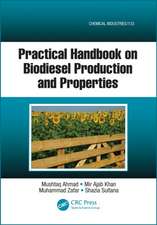Flow-Induced Pulsation and Vibration in Hydroelectric Machinery: Engineer’s Guidebook for Planning, Design and Troubleshooting
Autor Peter Dörfler, Mirjam Sick, André Coutuen Limba Engleză Paperback – 20 sep 2014
Typical phenomena are described to assist in the proper diagnosis of problems and various key strategies for solution are compared and considered with support from practical experience and real-life examples. The link between state-of the-art CFD computation and notorious practical problems is discussed and quantitative data is provided on normal levels of vibration and pulsation so realistic limits can be set for future projects. Current projects are also addressed as the possibilities and limitations of reduced-scale model tests for prediction of prototype performance are explained.
Engineers and project planners struggling with the practical problems will find Flow-induced Pulsation and Vibration in Hydroelectric Machinery to be a comprehensive and convenient reference covering key topics and ideas across a range of relevant disciplines.
| Toate formatele și edițiile | Preț | Express |
|---|---|---|
| Paperback (1) | 779.89 lei 6-8 săpt. | |
| SPRINGER LONDON – 20 sep 2014 | 779.89 lei 6-8 săpt. | |
| Hardback (1) | 1110.72 lei 6-8 săpt. | |
| SPRINGER LONDON – 28 aug 2012 | 1110.72 lei 6-8 săpt. |
Preț: 779.89 lei
Preț vechi: 951.08 lei
-18% Nou
Puncte Express: 1170
Preț estimativ în valută:
149.23€ • 156.23$ • 123.48£
149.23€ • 156.23$ • 123.48£
Carte tipărită la comandă
Livrare economică 05-19 aprilie
Preluare comenzi: 021 569.72.76
Specificații
ISBN-13: 9781447157953
ISBN-10: 1447157958
Pagini: 268
Ilustrații: XXIV, 244 p.
Dimensiuni: 155 x 235 x 14 mm
Greutate: 0.38 kg
Ediția:2013
Editura: SPRINGER LONDON
Colecția Springer
Locul publicării:London, United Kingdom
ISBN-10: 1447157958
Pagini: 268
Ilustrații: XXIV, 244 p.
Dimensiuni: 155 x 235 x 14 mm
Greutate: 0.38 kg
Ediția:2013
Editura: SPRINGER LONDON
Colecția Springer
Locul publicării:London, United Kingdom
Public țintă
Professional/practitionerCuprins
1.Basic Concepts.- 2.Low-frequency phenomena in swirling flow.- 3.Periodic effects of runner-casing interaction.- 4.High-frequency vortex phenomena.- 5.Cavitation-related phenomena.- 6.Stability-related unsteady phenomena.- 7.Model tests, techniques and results.- 8.Selected field experience.- 9.Practical Guidelines.
Notă biografică
Peter Dörfler, M.Eng., Ph.D., has been doing specific research in the area of hydraulic oscillations and transients covering tests at laboratory models and prototype machines, literature surveys and his own publications since 1978. He has issued numerous internal regulations and design rules for the prevention of instability and vibration in water turbines and pumps. He has led many successful troubleshooting campaigns concerning vibration problems in machines of own or third-party design.
Mirjam Sick, M.Eng., Ph.D., MBA, is Head of the Engineering Methods Department which comprises the major computational methods in hydraulic turbine development: fluid dynamics, structural mechanics and dynamic system analysis in the hydraulic R&D department of ANDRITZ HYDRO. With many years of experience as a research engineer in the field of computational fluid dynamics (CFD) she has been pursuing R&D in the field of fluid-structure coupling, dynamic load and multi physics during the last 5 years and has been involved in numerous cases of trouble shooting and root cause analysis.
With the hydro business of GE (now Andritz Hydro) since 1980, André Coutu, Eng., M.Eng., MBA, progressed through increasingly complex technical assignments within the business and now supervises mechanical analysis and mechanical R&D projects at the Andritz Hydro Francis turbines Center of Competence (CoC) in Montréal. He had decisive involvement in solving many complex site and shop mechanical issues and has published several papers related to hydraulic turbines’ mechanical behavior.
Mirjam Sick, M.Eng., Ph.D., MBA, is Head of the Engineering Methods Department which comprises the major computational methods in hydraulic turbine development: fluid dynamics, structural mechanics and dynamic system analysis in the hydraulic R&D department of ANDRITZ HYDRO. With many years of experience as a research engineer in the field of computational fluid dynamics (CFD) she has been pursuing R&D in the field of fluid-structure coupling, dynamic load and multi physics during the last 5 years and has been involved in numerous cases of trouble shooting and root cause analysis.
With the hydro business of GE (now Andritz Hydro) since 1980, André Coutu, Eng., M.Eng., MBA, progressed through increasingly complex technical assignments within the business and now supervises mechanical analysis and mechanical R&D projects at the Andritz Hydro Francis turbines Center of Competence (CoC) in Montréal. He had decisive involvement in solving many complex site and shop mechanical issues and has published several papers related to hydraulic turbines’ mechanical behavior.
Textul de pe ultima copertă
Since the 1970’s, an increasing amount of specialized research has focused on the problems created by instability of internal flow in hydroelectric power plants. However, progress in this field is hampered by the interdisciplinary nature of the subject, between fluid mechanics, structural mechanics and hydraulic transients. Flow-induced Pulsation and Vibration in Hydroelectric Machinery provides a compact guidebook explaining the many different underlying physical mechanisms and their possible effects.
Typical phenomena are described to assist in the proper diagnosis of problems and various key strategies for solution are compared and considered with support from practical experience and real-life examples. The link between state-of the-art CFD computation and notorious practical problems is discussed and quantitative data is provided on normal levels of vibration and pulsation so realistic limits can be set for future projects. Current projects are also addressed as the possibilities and limitations of reduced-scale model tests for prediction of prototype performance are explained.
Engineers and project planners struggling with practical problems will find Flow-induced Pulsation and Vibration in Hydroelectric Machinery to be a comprehensive and convenient reference covering key topics and ideas across a range of relevant disciplines.
Typical phenomena are described to assist in the proper diagnosis of problems and various key strategies for solution are compared and considered with support from practical experience and real-life examples. The link between state-of the-art CFD computation and notorious practical problems is discussed and quantitative data is provided on normal levels of vibration and pulsation so realistic limits can be set for future projects. Current projects are also addressed as the possibilities and limitations of reduced-scale model tests for prediction of prototype performance are explained.
Engineers and project planners struggling with practical problems will find Flow-induced Pulsation and Vibration in Hydroelectric Machinery to be a comprehensive and convenient reference covering key topics and ideas across a range of relevant disciplines.
Caracteristici
Describes typical phenomena to enable engineers to diagnose problems properly and compare the pertinent strategies for solutions Provides planners with quantitative data about normal levels of vibration and pulsation that permit them to specify realistic limits for new projects Uses case studies to show the link between state-of the-art CFD computation and notorious practical problems Includes supplementary material: sn.pub/extras























